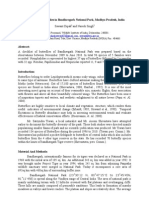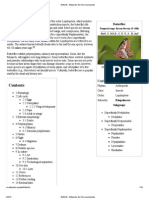0 ratings0% found this document useful (0 votes)
47 viewsInsect Reproductive System
Insect Reproductive System
Uploaded by
Liezl Bornales ParreñoThe insect reproductive system consists of internal and external structures. Internally, females have ovaries that produce eggs and spermathecae that store sperm. Males have testes that produce sperm. Externally, males have genitalia like the aedeagus that are used to transmit sperm during mating. Females have an ovipositor used to lay eggs. The external genitalia show diversity between species and are often used for species identification.
Copyright:
© All Rights Reserved
Available Formats
Download as DOCX, PDF, TXT or read online from Scribd
Insect Reproductive System
Insect Reproductive System
Uploaded by
Liezl Bornales Parreño0 ratings0% found this document useful (0 votes)
47 views3 pagesThe insect reproductive system consists of internal and external structures. Internally, females have ovaries that produce eggs and spermathecae that store sperm. Males have testes that produce sperm. Externally, males have genitalia like the aedeagus that are used to transmit sperm during mating. Females have an ovipositor used to lay eggs. The external genitalia show diversity between species and are often used for species identification.
Original Description:
a lesson in Grade 5
Copyright
© © All Rights Reserved
Available Formats
DOCX, PDF, TXT or read online from Scribd
Share this document
Did you find this document useful?
Is this content inappropriate?
The insect reproductive system consists of internal and external structures. Internally, females have ovaries that produce eggs and spermathecae that store sperm. Males have testes that produce sperm. Externally, males have genitalia like the aedeagus that are used to transmit sperm during mating. Females have an ovipositor used to lay eggs. The external genitalia show diversity between species and are often used for species identification.
Copyright:
© All Rights Reserved
Available Formats
Download as DOCX, PDF, TXT or read online from Scribd
Download as docx, pdf, or txt
0 ratings0% found this document useful (0 votes)
47 views3 pagesInsect Reproductive System
Insect Reproductive System
Uploaded by
Liezl Bornales ParreñoThe insect reproductive system consists of internal and external structures. Internally, females have ovaries that produce eggs and spermathecae that store sperm. Males have testes that produce sperm. Externally, males have genitalia like the aedeagus that are used to transmit sperm during mating. Females have an ovipositor used to lay eggs. The external genitalia show diversity between species and are often used for species identification.
Copyright:
© All Rights Reserved
Available Formats
Download as DOCX, PDF, TXT or read online from Scribd
Download as docx, pdf, or txt
You are on page 1of 3
Insect reproductive system
From Wikipedia, the free encyclopedia
Jump to navigationJump to search
Most insects reproduce oviparously, i.e. by laying eggs. The eggs are produced by the female in
a pair of ovaries. Sperm, produced by the male in one testis or more commonly two, is
transmitted to the female during mating by means of external genitalia. The sperm is stored
within the female in one or more spermathecae. At the time of fertilization, the eggs travel
along oviducts to be fertilized by the sperm and are then expelled from the body ("laid"), in
most cases via an ovipositor.
Contents
1Internal
o 1.1Female
o 1.2Male
2External
o 2.1Genitalia
3See also
4References
Internal[edit]
Female[edit]
The female genitalia of Lepidoptera
Female insects are able to make eggs, receive and store sperm, manipulate sperm from different
males, and lay eggs. Their reproductive systems are made up of a pair of ovaries, accessory
glands, one or more spermathecae, and ducts connecting these parts. The ovaries make eggs and
accessory glands produce the substances to help package and lay the eggs. Spermathecae store
sperm for varying periods of time and, along with portions of the oviducts, can control sperm
use. The ducts and spermathecae are lined with a cuticle.[1]:880
The ovaries are made up of a number of egg tubes, called ovarioles, which vary in size and
number by species. The number of eggs that the insect is able to make varies according to the
number of ovarioles, with the rate at which eggs develop being also influenced by ovariole
design. In meroistic ovaries, the eggs-to-be divide repeatedly and most of the daughter cells
become helper cells for a single oocyte in the cluster. In panoistic ovaries, each egg-to-be
produced by stem germ cells develops into an oocyte; there are no helper cells from the germ
line. Production of eggs by panoistic ovaries tends to be slower than that by meroistic
ovaries.[1]:880
Accessory glands or glandular parts of the oviducts produce a variety of substances for sperm
maintenance, transport, and fertilization, as well as for protection of eggs. They can produce
glue and protective substances for coating eggs or tough coverings for a batch of eggs
called oothecae. Spermathecae are tubes or sacs in which sperm can be stored between the time
of mating and the time an egg is fertilized. Paternity testing of insects has revealed that some,
and probably many, female insects use the spermatheca and various ducts to control or bias
sperm used in favor of some males over others.[1]:880
Male[edit]
Male genitalia of Lepidoptera
The main component of the male reproductive system is the testis, suspended in the body cavity
by tracheae and the fat body. The more primitive apterygote insects have a single testis, and in
some lepidopterans the two maturing testes are secondarily fused into one structure during the
later stages of larval development, although the ducts leading from them remain separate.
However, most male insects have a pair of testes, inside of which are sperm tubes or follicles
that are enclosed within a membranous sac. The follicles connect to the vas deferens by the vas
efferens, and the two tubular vasa deferentia connect to a median ejaculatory duct that leads to
the outside. A portion of the vas deferens is often enlarged to form the seminal vesicle, which
stores the sperm before they are discharged into the female. The seminal vesicles have glandular
linings that secrete nutrients for nourishment and maintenance of the sperm. The ejaculatory
duct is derived from an invagination of the epidermal cells during development and, as a result,
has a cuticular lining. The terminal portion of the ejaculatory duct may be sclerotized to form
the intromittent organ, the aedeagus. The remainder of the male reproductive system is derived
from embryonic mesoderm, except for the germ cells, or spermatogonia, which descend from
the primordial pole cells very early during embryogenesis.[1]:885
External[edit]
Variety of male structures in Phlebotominae (Diptera, Psychodidae)
The ground plan of the abdomen of an adult insect typically consists of 11–12 segments and is
less strongly sclerotized than the head or thorax. Each segment of the abdomen is represented
by a sclerotized tergum, sternum, and perhaps a pleurite. Terga are separated from each other
and from the adjacent sterna or pleura by a membrane. Spiracles are located in the pleural area.
Variation of this ground plan includes the fusion of terga or terga and sterna to form continuous
dorsal or ventral shields or a conical tube. Some insects bear a sclerite in the pleural area called
a laterotergite. Ventral sclerites are sometimes called laterosternites. During the embryonic
stage of many insects and the postembryonic stage of primitive insects, 11 abdominal segments
are present. In modern insects there is a tendency toward reduction in the number of the
abdominal segments, but the primitive number of 11 is maintained during embryogenesis.
Variation in abdominal segment number is considerable. If the Apterygota are considered to be
indicative of the ground plan for pterygotes, confusion reigns: adult Protura have 12 segments,
Collembola have 6. The orthopteran family Acrididae has 11 segments, and a fossil specimen of
Zoraptera has a 10-segmented abdomen.[1]
Generally, the first seven abdominal segments of adults (the pregenital segments) are similar in
structure and lack appendages. However, apterygotes (bristletails and silverfish) and many
immature aquatic insects have abdominal appendages. Apterygotes possess a pair of styles;
rudimentary appendages that are serially homologous with the distal part of the thoracic legs.
And, mesally, one or two pairs of protrusible (or exsertile) vesicles on at least some abdominal
segments. These vesicles are derived from the coxal and trochanteral endites (inner annulated
lobes) of the ancestral abdominal appendages. Aquatic larvae and nymphs may have gills
laterally on some to most abdominal segments.[2]:49 Of the rest of the abdominal segments
consist of the reproductive and anal parts.
The anal-genital part of the abdomen, known as the terminalia, consists generally of segments 8
or 9 to the abdominal apex. Segments 8 and 9 bear the genitalia; segment 10 is visible as a
complete segment in many "lower" insects but always lacks appendages; and the small segment
11 is represented by a dorsal epiproct and pair of ventral paraprocts derived from the sternum. A
pair of appendages, the cerci, articulates laterally on segment 11; typically these are annulated
and filamentous but have been modified (e.g. the forceps of earwigs) or reduced in different
insect orders. An annulated caudal filament, the median appendix dorsalis, arises from the tip of
the epiproct in apterygotes, most mayflies (Ephemeroptera), and a few fossil insects. A similar
structure in nymphal stoneflies (Plecoptera) is of uncertain homology. These terminal
abdominal segments have excretory and sensory functions in all insects, but in adults there is an
additional reproductive function.[2]:49
Genitalia[edit]
See also: Aedeagus, Lepidoptera genitalia, and Paramere
The organs concerned specifically with mating and the deposition of eggs are known
collectively as the external genitalia, although they may be largely internal. The components of
the external genitalia of insects are very diverse in form and often have considerable taxonomic
value, particularly among species that appear structurally similar in other respects. The male
external genitalia have been used widely to aid in distinguishing species, whereas the female
external genitalia may be simpler and less varied.
The terminalia of adult female insects include internal structures for receiving the male
copulatory organ and his spermatozoa, and external structures used for oviposition (egg-laying).
Most female insects have an egg-laying tube, or ovipositor; it is absent in termites, parasitic
lice, many Plecoptera, and most Ephemeroptera. Ovipositors take two forms:
1. true, or appendicular, formed from appendages of abdominal
segments 8 and 9;
1. substitutional, composed of extensible posterior abdominal
segments.
You might also like
- Science: Quarter 2 - Module 3 External Parts and Functions of AnimalsDocument21 pagesScience: Quarter 2 - Module 3 External Parts and Functions of AnimalsRobieDeLeon100% (13)
- Basic Medical Language 6th Brooks Test BankDocument12 pagesBasic Medical Language 6th Brooks Test BankRamiqq100% (1)
- Butterflies of BandhavgarhDocument7 pagesButterflies of BandhavgarhDipak SawantNo ratings yet
- 8 Stored Products-Food, Fabric FDocument21 pages8 Stored Products-Food, Fabric FselvakrishnaNo ratings yet
- Snakes Biting MechanismDocument7 pagesSnakes Biting Mechanismnancy sharmaNo ratings yet
- Ex. No. 9. - Observing The Characters of Apterygota - Collembola and Thysanura and Exopterygota - Odonata, Ephemeroptera and PhasmidaDocument28 pagesEx. No. 9. - Observing The Characters of Apterygota - Collembola and Thysanura and Exopterygota - Odonata, Ephemeroptera and Phasmidaakshayaa aswanthNo ratings yet
- Insect Reproduction: Entomology (BIOL 409) Fall 2004, Lecture # 21Document18 pagesInsect Reproduction: Entomology (BIOL 409) Fall 2004, Lecture # 21Reube RonnyNo ratings yet
- Week Lecture Cotton PestDocument19 pagesWeek Lecture Cotton PestAkbar ZamanNo ratings yet
- Apiculture NotesDocument28 pagesApiculture Notesgarimaupadhyay20002No ratings yet
- Lec4 SocialInsects TheSociety NotesDocument3 pagesLec4 SocialInsects TheSociety NotesAlexandra LvNo ratings yet
- Phylum NematodaDocument24 pagesPhylum NematodaKaten KyoukotsuNo ratings yet
- Stored Pests in MyanmarDocument27 pagesStored Pests in Myanmarapi-313509942100% (1)
- Amphibia-Parental CareDocument4 pagesAmphibia-Parental CareAakash VNo ratings yet
- Genome Organization in E. ColiDocument7 pagesGenome Organization in E. ColiAman KhanNo ratings yet
- Type of EggDocument4 pagesType of EggFina NafrillaNo ratings yet
- Rice Stripped Stem Borer Chilo Suppressalis (Noctuidae Lepidoptera)Document14 pagesRice Stripped Stem Borer Chilo Suppressalis (Noctuidae Lepidoptera)Akbar ZamanNo ratings yet
- APPLIED ENTOMOLOGY-PESTS OF MAIZE and SORGHUMDocument26 pagesAPPLIED ENTOMOLOGY-PESTS OF MAIZE and SORGHUMTehreem AfzalNo ratings yet
- Potato Tuber MothDocument18 pagesPotato Tuber MothAiswarya M KNo ratings yet
- Phylum PoriferaDocument2 pagesPhylum PoriferayashsodhaniNo ratings yet
- MarchantiophytaDocument9 pagesMarchantiophytax456456456xNo ratings yet
- Clasification of InsectsDocument68 pagesClasification of InsectsMarie Serena McConnellNo ratings yet
- Bryophytes NoteDocument58 pagesBryophytes NoteSaurav YadavNo ratings yet
- Faculty of Biotechnology: Heterosproty and Evolution of Seed HabitatDocument9 pagesFaculty of Biotechnology: Heterosproty and Evolution of Seed HabitatRajat SinghNo ratings yet
- Zoology Chapter 4Document67 pagesZoology Chapter 4Driver Hafizur RahmanNo ratings yet
- Bio Control PPT 11Document27 pagesBio Control PPT 11brij99100% (2)
- Sitophilus OryzaeDocument7 pagesSitophilus OryzaeMayuri Vohra100% (1)
- Grasshoppers and LocustsDocument200 pagesGrasshoppers and LocustsSãrwår Jæñ50% (2)
- TMP 79 CFDocument256 pagesTMP 79 CFFrontiersNo ratings yet
- ST Wilfred CollegeDocument27 pagesST Wilfred CollegeharishgnrNo ratings yet
- Occurrence of CharaDocument12 pagesOccurrence of CharaPunam Tamang100% (1)
- Fungi-Definition, Examples, Structure, Classification & ReproductionDocument26 pagesFungi-Definition, Examples, Structure, Classification & Reproductionarissa noorNo ratings yet
- Presentation Draft: Course No.: 501 Course Title: MycologyDocument48 pagesPresentation Draft: Course No.: 501 Course Title: Mycologysidhu_agricoNo ratings yet
- ButterflyDocument13 pagesButterflyashisb444No ratings yet
- Evolution of Sporophytes and Gametophytes in BryophytesDocument7 pagesEvolution of Sporophytes and Gametophytes in BryophytesKhan KhanNo ratings yet
- Lecture 16 Feb 19 Trematode-1Document29 pagesLecture 16 Feb 19 Trematode-1Rajkumar MandalNo ratings yet
- Definition of AllelochemicalsDocument7 pagesDefinition of AllelochemicalsrubyNo ratings yet
- Orthoptera, DictyopteraDocument35 pagesOrthoptera, DictyopterapurbaliNo ratings yet
- Life Cycle of GnetumDocument10 pagesLife Cycle of GnetumChandan Patra100% (1)
- Genetic Improvement in Honey BeesDocument18 pagesGenetic Improvement in Honey BeesSandeep kumar SathuaNo ratings yet
- Chlorophyceae: VolvoxDocument13 pagesChlorophyceae: VolvoxAnilNo ratings yet
- Equisetum: RamosissimumDocument7 pagesEquisetum: RamosissimumChithra VijayanNo ratings yet
- Anthoceros ANTHOCEROS (Hornwort) : Morphology of ThallusDocument3 pagesAnthoceros ANTHOCEROS (Hornwort) : Morphology of ThallusyeateshwarriorNo ratings yet
- BIRDS ActivityDocument13 pagesBIRDS ActivityMudasir SalikNo ratings yet
- What Is ParthenocarpyDocument2 pagesWhat Is ParthenocarpyAadil Khan Gandapur100% (1)
- Excretion in InsectsDocument58 pagesExcretion in InsectsMani VasagamNo ratings yet
- Insect Ecology (Fourth Edition), 2016 - Timothy SchowalterDocument12 pagesInsect Ecology (Fourth Edition), 2016 - Timothy SchowalterJefferson SepúlvedaNo ratings yet
- Cigarette Beetle: Lasioderma SerricorneDocument2 pagesCigarette Beetle: Lasioderma SerricorneMiftah Farid100% (1)
- ENTO 489 Internal Anatomy of Honey Bees: Malpighian TubulesDocument9 pagesENTO 489 Internal Anatomy of Honey Bees: Malpighian TubulesAlex ReyesNo ratings yet
- Life Cycle of OedogoniumDocument16 pagesLife Cycle of OedogoniumMuskan Sachdeva 0047No ratings yet
- MetamorphosisDocument110 pagesMetamorphosisShivaniNo ratings yet
- Basic Entomology III - Insect OrdersDocument35 pagesBasic Entomology III - Insect Ordershendry100% (1)
- Incredible Insects - How Do Flies Breathe With No Lungs?Document1 pageIncredible Insects - How Do Flies Breathe With No Lungs?Kelsey WosnitzkaNo ratings yet
- Care Sheet - Emma Gray's Forest LizardDocument2 pagesCare Sheet - Emma Gray's Forest LizardJohn Gamesby100% (1)
- Insect HeadDocument24 pagesInsect Headhuzaifa.netflixxNo ratings yet
- Cyclic AMP Signalling PathwayDocument5 pagesCyclic AMP Signalling Pathwayrawatpooran05No ratings yet
- Metamorphism in InsectsDocument24 pagesMetamorphism in Insectsyayeg raja100% (1)
- Kuliah 17 - Nematoda Dan ProtozoaDocument72 pagesKuliah 17 - Nematoda Dan ProtozoaivaNo ratings yet
- Lecture 3 - Intro. To MetazoaDocument30 pagesLecture 3 - Intro. To MetazoaGammee Or100% (1)
- Life Cycle of Eisenia FetidaDocument2 pagesLife Cycle of Eisenia Fetidahassanainshahi13100% (1)
- Non-Marine Paleoclimate Records: Pollen DataDocument39 pagesNon-Marine Paleoclimate Records: Pollen DataAbdullah OmerNo ratings yet
- Ant Mating Chart: FilterDocument1 pageAnt Mating Chart: Filtercorvus35No ratings yet
- Radio Imagistica EsofaguluiDocument192 pagesRadio Imagistica EsofaguluimyreadNo ratings yet
- Current Bibliography of The History of Science and Its Cultural InfluencesDocument361 pagesCurrent Bibliography of The History of Science and Its Cultural InfluencesOzgur KorpeNo ratings yet
- Soal Pas 1 Kelas 7 2021-2022Document2 pagesSoal Pas 1 Kelas 7 2021-2022Reza Gunandi FadillahNo ratings yet
- 3rd Unit Test in ScienceDocument1 page3rd Unit Test in ScienceAileen AlorroNo ratings yet
- Evidence of Evolution AERON DEL SOCORRODocument9 pagesEvidence of Evolution AERON DEL SOCORROJezysaint Ruth Del Socorro100% (1)
- Body PartDocument100 pagesBody PartClarissa Muliawan100% (1)
- Report Text (Panda) YttaDocument3 pagesReport Text (Panda) YttakitnaradengandasklhNo ratings yet
- DLL - Science 6 - Q2 - W1Document6 pagesDLL - Science 6 - Q2 - W1Julius Beralde0% (1)
- Science6 Q2 Mod3 ExplainHowTheDifferentOrganSystemWorksTogether V4Document24 pagesScience6 Q2 Mod3 ExplainHowTheDifferentOrganSystemWorksTogether V4Jonel Buergo100% (2)
- Wed 5680143 B 02620Document1 pageWed 5680143 B 02620SANY TVNo ratings yet
- An Introduction To: The Respiratory SystemDocument22 pagesAn Introduction To: The Respiratory SystemSHANJIDA ALI RIANo ratings yet
- Cell ReproductionDocument20 pagesCell ReproductionPatricia Anne GamatanNo ratings yet
- Fonseka DragonfliesDocument320 pagesFonseka DragonfliesKithmini Ouchithya WickramarachchiNo ratings yet
- Definition of Terms in Anatomy and Physiology - AssignmentDocument4 pagesDefinition of Terms in Anatomy and Physiology - Assignmentcriselda desistoNo ratings yet
- Soal Digestive SystemDocument3 pagesSoal Digestive SystemEMIL SALNo ratings yet
- Taxidermy - EtsyDocument1 pageTaxidermy - EtsybrianneboucekNo ratings yet
- Animal Phylum PosterDocument1 pageAnimal Phylum PosterBrijesh SinghNo ratings yet
- Human Body Systems Essential VocabularyDocument6 pagesHuman Body Systems Essential Vocabularyapi-261172766No ratings yet
- Role of Isolation in EvolutionDocument14 pagesRole of Isolation in EvolutionMalaika NoorNo ratings yet
- Vertebrates and InvertebratesDocument3 pagesVertebrates and InvertebratesShar Nur JeanNo ratings yet
- Arlene Amaro Science-4-CotDocument7 pagesArlene Amaro Science-4-CotARLENE T. AMARONo ratings yet
- Compendium of Histology: A Theoretical and Practical GuideDocument670 pagesCompendium of Histology: A Theoretical and Practical GuideMichelle CastañedaNo ratings yet
- TLE10-This Is MeatDocument18 pagesTLE10-This Is MeatJoy April Aguilar DeGuzmanNo ratings yet
- HirudineaDocument1 pageHirudineaEulia MerelosNo ratings yet
- Natural SelectionDocument4 pagesNatural SelectionJumana Shahata100% (1)
- Class 7 - Nutrition in AnimalsDocument20 pagesClass 7 - Nutrition in AnimalsSMKNo ratings yet
- Lion King's Adopted SonDocument242 pagesLion King's Adopted SonLynlady-Ann TirolNo ratings yet

























































































